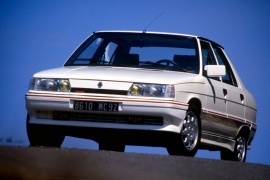
RENAULT 9
Generations Timeline, Specs and Pictures

Elected as the European Car of the Year in 1982, the Renault 9 was sold in over one million units over its nine-year lifespan.
In 1986 it received a well-deserved facelift.
Back in the ’80s, the cubist style was the king in the design departments. Apart from some Italian vehicles, most of them were designed with straight, sharp lines, such as the Volvo, Volkswagen Golf/Jetta/Passat, Audi 80/100, and Renault. The latter offered the 9 model as the sedan version for the 11 hatchback. It was a light, fuel-efficient family car that could carry four passengers and some luggage.
The 1986 version was slightly updated from the design point of view. At the front, it sported more sweeping headlights inspired by its bigger brother, the 25. There was a very slim grille between the hood and the wrapped-around plastic bumper. Depending on the trim level, it was either black or body-colored. The Turbo version featured magnesium wheels and a unique aerodynamic package.
Inside, the little French car featured slim seats at the front with minimal side bolstering. Apart from the 115 hp Turbo version, it wasn’t a sporty vehicle. Its square design was kept for the instrument cluster, but there was a new, two-spoke steering wheel.
Under the hood, Renault revised the engine lineup. It was still offered with an old, 1.3-liter 54 hp engine for the base model. A 1.6-liter diesel engine was available for those who needed a very fuel-efficient vehicle. Renault tried to sell the car in North America under the name Renault Alliance, but it failed and bailed out in 1987.

In 1981 at the Frankfurt Motor Show, Renault was presenting the Renault 9, a 4-door saloon designed for customers looking for a family car with low running costs.
The Renault 9 was a four-meter sedan with a front-wheel drive engine configuration that immediately won the European Car of the Year title in 1982.
A number of high-strength steel parts were used in the car’s structure, including the center cab pillars, the front cowl sections and the floor. The body was treated with anti-corrosion protection, while the floor and other parts were treated with protective sprays. Renault aimed to offer safety and the highest possible durability for the model.
The production of the Renault 9 required a modernised plant, able to produce more cars in a shorter period of time, thus, 125 robots were installed and the capacity grown to over a thousand cars a day.
The car came on the market with 2 4-cylinder petrol engines, 1108cm3 and 1397 cm3, the first developing 47.5 hp and the other one 72hp. Most of them were equipped with a 4-speed manual transmission, while the more powerful version of the 1.4-liter engine had a 5-speed manual transmission - and came with an additional charge.
With a wheelbase of 2477mm, the car was 4062mm long, 1650mm wide and 1405mm high. The rear compartment had a volume of 402 L.
The spare wheel under the luggage compartment floor was accessible from the outside and the thank could hold 47 liters of petrol. The vehicle’s weight ranged from 805 to 840 kg.























































